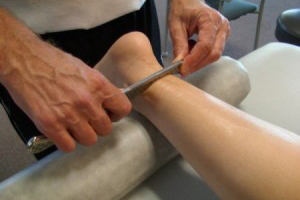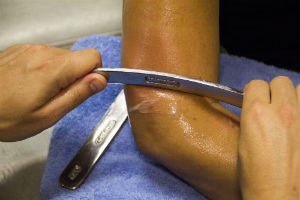This technique uses specifically designed instruments to efficiently locate and treat individuals diagnosed with soft-tissue dysfunction. A soft-tissue injury involves damage to the muscles, ligaments, tendons and/or fascia somewhere in the body. Common soft-tissue injuries usually occur from a sprain, strain, blow to the body resulting in a contusion (ruptured blood vessels/bruising), or overuse of a particular body part. Soft tissue injuries can result in pain, swelling, bruising and loss of function. Adhesions within the soft tissue may develop as a result of repeated strain, surgery, immobilization or other mechanisms. Instrument Assisted Soft Tissue Mobilization can be used to help alleviate the following symptoms:

 How does it work?
Most people do not address a soft tissue injury until it has become chronic (weeks or months after the injury occurs). Our bodies initially respond to soft tissue injuries by laying down whatever free cells are available in the body at the time, creating a weave pattern to essentially close the holes. In order for the soft tissue to move freely again it needs to be remodeled by introducing controlled microtrauma to the affected soft tissue to stimulate a local inflammatory response. This microtrauma initiates reabsorption of inappropriate or excessive scar tissue and facilitates remodeling of the affected soft-tissue structures thereby restoring freedom of movement in the tissue. Also occurring during the remodeling process is restoration of blocked circulatory pathways to the tissue which will decrease associated pain.
How does it work?
Most people do not address a soft tissue injury until it has become chronic (weeks or months after the injury occurs). Our bodies initially respond to soft tissue injuries by laying down whatever free cells are available in the body at the time, creating a weave pattern to essentially close the holes. In order for the soft tissue to move freely again it needs to be remodeled by introducing controlled microtrauma to the affected soft tissue to stimulate a local inflammatory response. This microtrauma initiates reabsorption of inappropriate or excessive scar tissue and facilitates remodeling of the affected soft-tissue structures thereby restoring freedom of movement in the tissue. Also occurring during the remodeling process is restoration of blocked circulatory pathways to the tissue which will decrease associated pain.
What should I expect with this treatment?
The patient and practitioner will feel a “gritty sensation” when adhesions found. The patient should always let the practitioner know if procedure is become painful. Occasionally the patient may experience soreness and redness in the treatment area for a day or two after treatment due to histamine release and blood flow restoration to the area.
What is involved in a typical Instrument Assisted Soft Tissue Mobilization treatment session?